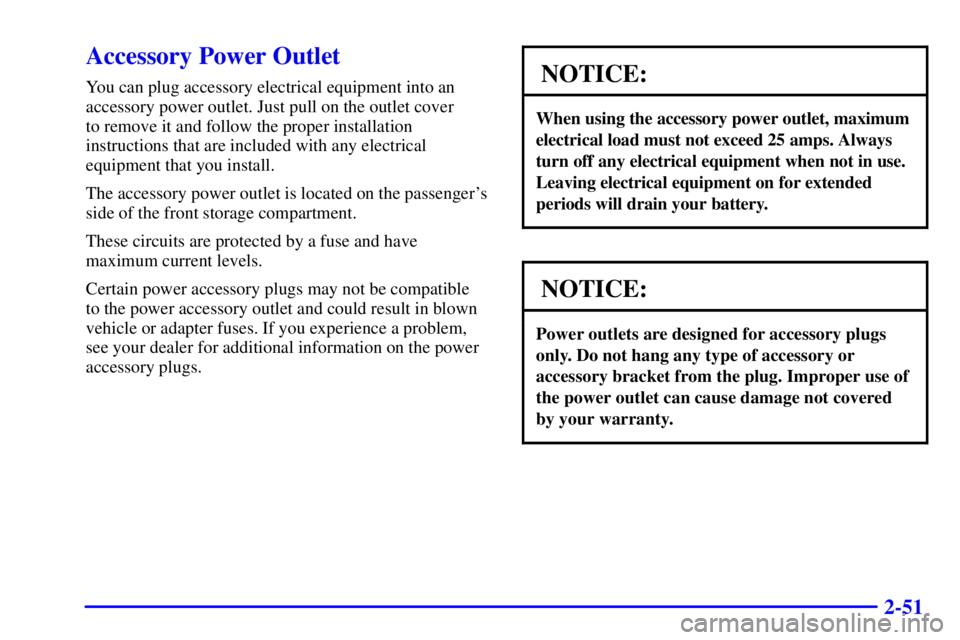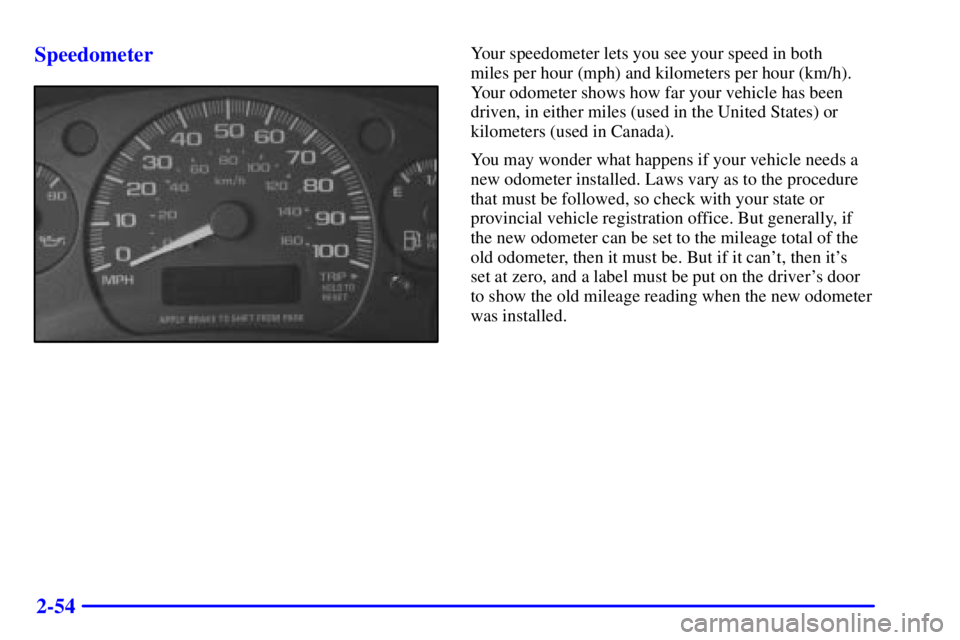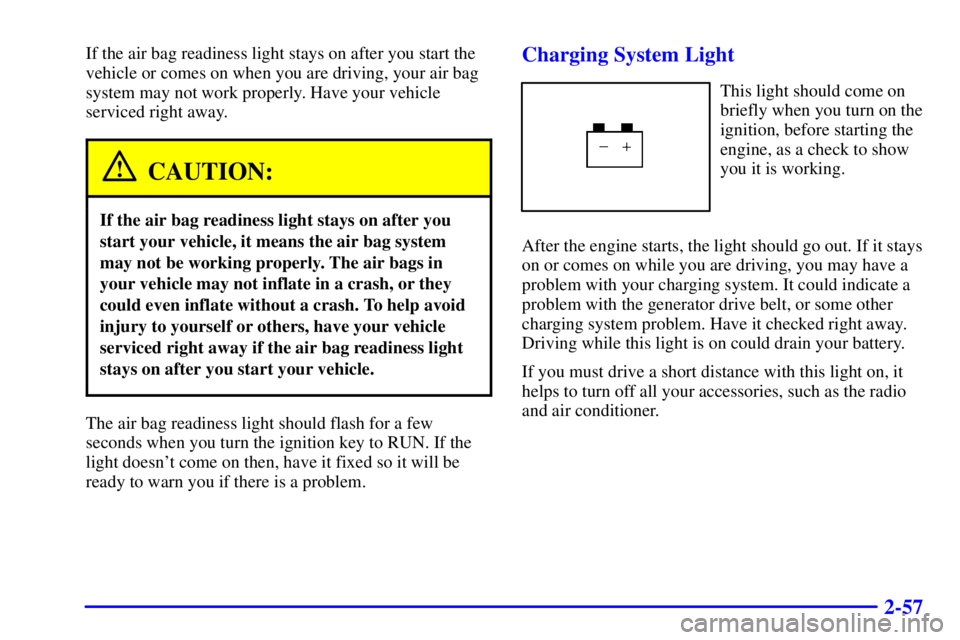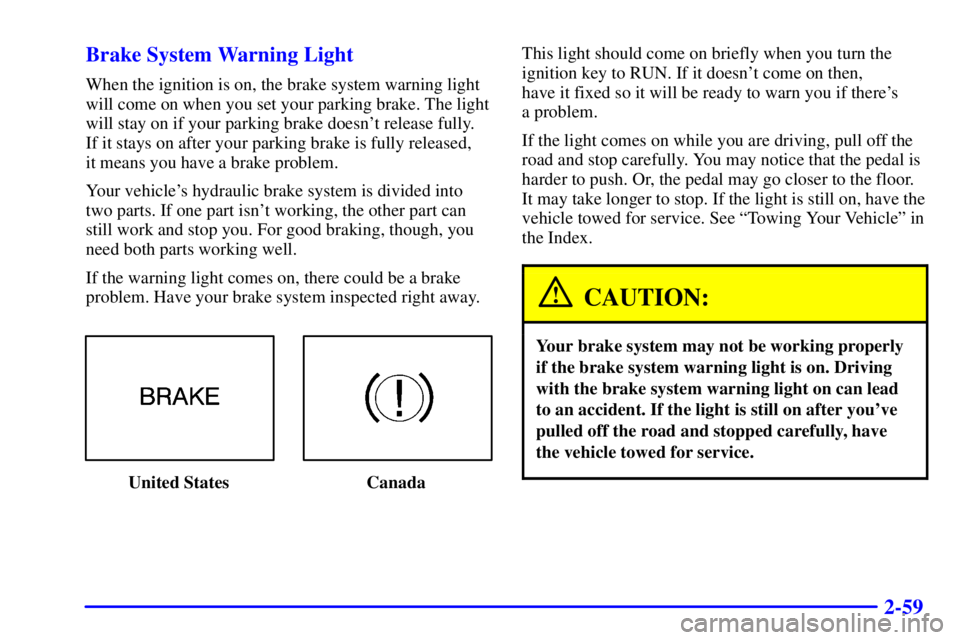CHEVROLET EXPRESS 1999 Owners Manual
Manufacturer: CHEVROLET, Model Year: 1999, Model line: EXPRESS, Model: CHEVROLET EXPRESS 1999Pages: 411, PDF Size: 2.69 MB
Page 121 of 411

2-50
NOTICE:
Holding a cigarette lighter in with your hand
while it is heating can make it overload,
damaging the lighter and the heating element.
Just push the lighter all the way in and let go.
When it's done, it will pop back by itself.
To remove the front ashtray, pull up on the tab with a
key or similar object inserted in the tab, and lift the
ashtray out.
Sun Visors
To block out glare, you can swing down the visors.
You can also swing them from side to side.
Visor Vanity Mirror (Option)
Some visors have mirrors built in, with or without
lamps. Just lift the mirror cover on each visor to turn the
lamps on, if you have them.
Page 122 of 411

2-51
Accessory Power Outlet
You can plug accessory electrical equipment into an
accessory power outlet. Just pull on the outlet cover
to remove it and follow the proper installation
instructions that are included with any electrical
equipment that you install.
The accessory power outlet is located on the passenger's
side of the front storage compartment.
These circuits are protected by a fuse and have
maximum current levels.
Certain power accessory plugs may not be compatible
to the power accessory outlet and could result in blown
vehicle or adapter fuses. If you experience a problem,
see your dealer for additional information on the power
accessory plugs.NOTICE:
When using the accessory power outlet, maximum
electrical load must not exceed 25 amps. Always
turn off any electrical equipment when not in use.
Leaving electrical equipment on for extended
periods will drain your battery.
NOTICE:
Power outlets are designed for accessory plugs
only. Do not hang any type of accessory or
accessory bracket from the plug. Improper use of
the power outlet can cause damage not covered
by your warranty.
Page 123 of 411

2-52
The Instrument Panel - Your Information System
The main components of your instrument panel are the following:
A. Lamp Control
B. Air Vents
C. Instrument Panel Cluster
D. Comfort Controls SystemE. Audio System
F. Turn Signal/Multifunction Lever
G. Horn
H. Convenience TrayI. Cigarette Lighter
J. Cupholder
K. Ashtray
Page 124 of 411

2-53
Instrument Panel Cluster
United States version shown, Canada similar
Your instrument panel cluster is designed to let you know at a glance how your vehicle is running. You'll know
how fast you're going, how much fuel you're using, and many other things you'll need to know to drive safely
and economically.
Page 125 of 411

2-54 Speedometer
Your speedometer lets you see your speed in both
miles per hour (mph) and kilometers per hour (km/h).
Your odometer shows how far your vehicle has been
driven, in either miles (used in the United States) or
kilometers (used in Canada).
You may wonder what happens if your vehicle needs a
new odometer installed. Laws vary as to the procedure
that must be followed, so check with your state or
provincial vehicle registration office. But generally, if
the new odometer can be set to the mileage total of the
old odometer, then it must be. But if it can't, then it's
set at zero, and a label must be put on the driver's door
to show the old mileage reading when the new odometer
was installed.
Page 126 of 411

2-55
Trip Odometer
The trip odometer can
tell you how far your
vehicle has been
driven since you last
set the trip odometer
to zero.
To reset the trip odometer, fully press the reset button
located near the trip odometer readout.
The trip odometer can show either total miles or trip
miles using this button located on the instrument cluster.
Electronic Road
-Speed Governor
(Gasoline Engines) (Option)
This optional system automatically controls top vehicle
speed. The system controller receives a signal from the
vehicle speed sensor and reduces power when the
vehicle speed reaches the maximum 65 mph (105 km/h)
governed speed.
Warning Lights, Gages and Indicators
This part describes the warning lights and gages that
may be on your vehicle. The pictures will help you
locate them.
Warning lights and gages can signal that something is
wrong before it becomes serious enough to cause an
expensive repair or replacement. Paying attention to
your warning lights and gages could also save you or
others from injury.
Warning lights come on when there may be or is a
problem with one of your vehicle's functions. As you
will see in the details on the next few pages, some
warning lights come on briefly when you start the
engine just to let you know they're working. If you are
familiar with this section, you should not be alarmed
when this happens.
Gages can indicate when there may be or is a problem
with one of your vehicle's functions. Often gages and
warning lights work together to let you know when
there's a problem with your vehicle.
Page 127 of 411

2-56
When one of the warning lights comes on and stays on
when you are driving, or when one of the gages shows
there may be a problem, check the section that tells you
what to do about it. Please follow this manual's advice.
Waiting to do repairs can be costly
-- and even
dangerous. So please get to know your warning lights
and gages. They're a big help.
Safety Belt Reminder Light
When the key is turned to RUN or START, a tone will
come on for about eight seconds to remind people to
fasten their safety belts, unless the driver's safety belt is
already buckled.
The safety belt light will
also come on and stay
on for about 20 seconds,
then it will flash for about
55 seconds.
If the driver's belt is already buckled, neither the tone
nor the light will come on.
Air Bag Readiness Light
There is an air bag readiness light on the instrument
panel, which shows AIR BAG or the air bag symbol.
The system checks the air bag's electrical system for
malfunctions. The light tells you if there is an electrical
problem. The system check includes the air bag sensor,
the air bag modules, the wiring and the crash sensing
and diagnostic module. For more information on the air
bag system, see ªAir Bagº in the Index.
United States Canada
This light will come on when you start your vehicle, and
it will flash for a few seconds. Then the light should go
out. This means the system is ready.
Page 128 of 411

2-57
If the air bag readiness light stays on after you start the
vehicle or comes on when you are driving, your air bag
system may not work properly. Have your vehicle
serviced right away.
CAUTION:
If the air bag readiness light stays on after you
start your vehicle, it means the air bag system
may not be working properly. The air bags in
your vehicle may not inflate in a crash, or they
could even inflate without a crash. To help avoid
injury to yourself or others, have your vehicle
serviced right away if the air bag readiness light
stays on after you start your vehicle.
The air bag readiness light should flash for a few
seconds when you turn the ignition key to RUN. If the
light doesn't come on then, have it fixed so it will be
ready to warn you if there is a problem.
Charging System Light
This light should come on
briefly when you turn on the
ignition, before starting the
engine, as a check to show
you it is working.
After the engine starts, the light should go out. If it stays
on or comes on while you are driving, you may have a
problem with your charging system. It could indicate a
problem with the generator drive belt, or some other
charging system problem. Have it checked right away.
Driving while this light is on could drain your battery.
If you must drive a short distance with this light on, it
helps to turn off all your accessories, such as the radio
and air conditioner.
Page 129 of 411

2-58 Voltmeter
When your engine is not
running, but the ignition is
on (in the RUN position),
this gage shows your
battery's state of charge
in DC volts.
When the engine is running, the gage shows the
condition of the charging system. Readings between
the low and high warning zones indicate the normal
operating range.Readings in the low warning zone may occur when
a large number of electrical accessories are operating
in the vehicle and the engine is left at an idle for an
extended period. This condition is normal since the
charging system is not able to provide full power at
engine idle. As engine speeds are increased, this
condition should correct itself as higher engine speeds
allow the charging system to create maximum power.
You can only drive for a short time with the reading
in either warning zone. If you must drive, turn off all
unnecessary accessories.
Readings in either warning zone indicate a possible
problem in the electrical system. Have the vehicle
serviced as soon as possible.
Page 130 of 411

2-59 Brake System Warning Light
When the ignition is on, the brake system warning light
will come on when you set your parking brake. The light
will stay on if your parking brake doesn't release fully.
If it stays on after your parking brake is fully released,
it means you have a brake problem.
Your vehicle's hydraulic brake system is divided into
two parts. If one part isn't working, the other part can
still work and stop you. For good braking, though, you
need both parts working well.
If the warning light comes on, there could be a brake
problem. Have your brake system inspected right away.
United States CanadaThis light should come on briefly when you turn the
ignition key to RUN. If it doesn't come on then,
have it fixed so it will be ready to warn you if there's
a problem.
If the light comes on while you are driving, pull off the
road and stop carefully. You may notice that the pedal is
harder to push. Or, the pedal may go closer to the floor.
It may take longer to stop. If the light is still on, have the
vehicle towed for service. See ªTowing Your Vehicleº in
the Index.
CAUTION:
Your brake system may not be working properly
if the brake system warning light is on. Driving
with the brake system warning light on can lead
to an accident. If the light is still on after you've
pulled off the road and stopped carefully, have
the vehicle towed for service.